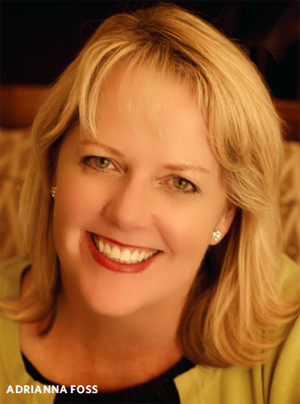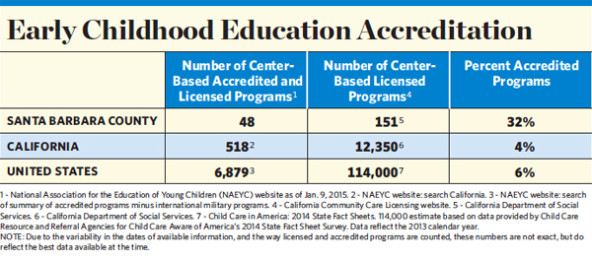On an overcast March morning, a dozen preschool children rush out through the doors of a former elementary school in downtown Carpinteria, Calif. The air suddenly fills with bursts of Spanish and English as a pair of teachers pull back tarps and haul buckets of toys. Unprompted, two little boys carry out a sand table for themselves, plopping it down several feet away. For the next several hours these teachers and children will play, nap, eat, and rest outdoors.
The Power of Philanthropic Partnerships

This special supplement looks closely at the lessons the Orfalea Fund has learned about how to create effective partnerships with nonprofits, government agencies, and other philanthropies.
-
“Where Two Rivers Meet, The Water Is Never Calm”
-
Migrating a Partnership Ethos
-
The Pillars of Partnership
-
Accepting the Challenges of Partnership
-
Valuing Stakeholders in Early Childhood Education
-
Early Lessons Propel a Movement
-
Building Disaster-Ready Philanthropy
-
Strengthening Santa Barbara County’s Disaster Resilience
-
Choosing the Right Partners for School Food Reform
-
A Changing Landscape for School Food
-
Lessons From a Sunsetting Fund
-
When to Lead, Follow, and Let Go
-
The Gates of Hope
Welcome to the outdoor classroom area of CAC Main, a nationally accredited Head Start preschool run by Santa Barbara County’s Community Action Commission. CAC Main is just one of the child-care centers in Santa Barbara County affected by The Orfalea Fund’s work in this area, which is overseen by Adrianna Foss, director of Early Childhood Education. The Outdoor Classroom Project sprang from research showing the profound impact of high-quality outdoor environments on every aspect of a young child’s cognitive, social, and physical development.
“Many children come from families that are very confined—there might be multiple families living in a single home,” says Theresa Embry, Outdoor Classroom Project coordinator. “They don’t have the ability to move around and to play. But physical activity is such an important thing for kids at this age. Young children need to be able to move.”
The Outdoor Classroom Project is just one component of the fund’s multifaceted approach to early childhood education, which has contributed to Santa Barbara County preschools’ achieving high-quality accreditation at eight times the California average rate. Barbara Andersen, director of strategic partnerships, spoke with Foss about building an engaged early care community, leadership development, and why the fund launched its own initiatives to change the culture of early childhood education in Santa Barbara County.
Barbara Andersen: The anxiety experienced by parents selecting an affordable, high-quality center with an available space can often feel insurmountable. In Santa Barbara County, The Orfalea Fund and First 5 of Santa Barbara County have worked together for more than a decade to address these concerns and fundamentally improve early childhood education leadership and practices. Based on accreditation statistics, it looks as though progress has been made.

Adrianna Foss: We transformed the ECE [early childhood education] sector in Santa Barbara County by valuing, recognizing, and supporting a sector that is underpaid and under-resourced, and isn’t given as much respect as it deserves. For the last 15 years, all the brain research has told us how important the early years are, but I don’t think people’s attitudes have caught up with the research to appreciate how important these preschool teachers and directors are to the well-being and long-term trajectory of the young children in their care.
Andersen: In most families, all of the adults work. Less than one-third of children have a full-time, stay-at-home parent. As a result, almost one-quarter of children under the age of 5 are in some form of organized childcare program, which includes preschools, Head Start, California State Preschool, and private and nonprofit programs.1 These centers affect a huge swath of our society.
Foss: Absolutely. Our fund’s ECE efforts support the development of a healthy whole-child vision, in which play and social-emotional development are not sacrificed for early academic programming. In Santa Barbara County, there are more than 150 early education centers, where thousands of kids spend 6 to 12 hours a day. These centers hold a key to the healthy development of our children, so we crafted an integrated strategy that included three main components: first, teacher and director education and professional development; second, national early childhood education quality accreditation; and third, whole-child programs including the Outdoor Classroom Project and the Preschool Food & Healthy Habits Initiative.
Teacher and Director Development
Andersen: A recent study showed that early childhood educators’ low wages resulted in workers feeling demoralized and lacking motivation to advance their careers.2 The fund’s earliest forays into ECE set out to address this situation, didn’t they?
Foss: That was a direct carryover from our business experience. Paul and Natalie Orfalea, and several of us here at the fund, spent our early careers at Kinko’s, where there was always an emphasis on valuing the frontline coworker. A lot of people talk about empowering others, but it’s really important to understand that the people we’re talking about, whether they are frontline retail coworkers or preschool teachers, already have enormous power. They hold the future of our customers or our children in their hands. They don’t need empowerment nearly as much as they need appreciation and attention. They need leadership development to make the most of the power they already have.
Andersen: Was that the impetus for the Center Director Retreats?
Foss: Yes. We saw that ECE directors were a lot like Kinko’s managers, in that they faced common challenges but lacked opportunities to network and share ideas. We based the ECE Center Directors Retreat on the Kinko’s Picnic, an annual gathering of the tribe with educational opportunities, a trade show, and ample time for personal interaction and sharing of best practices.
The retreat was a three-day event for the directors and teachers of child development and early care education centers in Santa Barbara County. The purpose was to provide cutting-edge education, inspiration, networking opportunities, and tools. We always did a tour of two or three local centers, so that rather than just talking about quality practices, we could actually see and borrow ideas from other high-quality centers. We also encouraged two people from each center to attend, rather than the director alone, to improve accountability for implementing what was learned, and because we wanted every center to think about leadership development and bench strength.
Andersen: These annual gatherings began to feel like family reunions. Many of the same directors and teachers attended year after year. Would you say these personal connections helped create a tight and active ECE sector in Santa Barbara County?
Foss: Absolutely. And that’s essential because one thing that I always try to focus on is making our work transformational. We’re trying to change not just the activities people do, but who they are when they’re with children, how they present themselves, and what view they have of their role in the lives of the children and the families in their centers. We knew from the beginning that we wouldn’t always be there, so we needed the ECE community to be ready to lead itself.
Andersen: The fund hosted ten annual retreats, but now it takes a different approach.
Foss: The retreat evolved into the Directors Leadership Series, through a partnership with the Santa Barbara County Child Care Planning Council. Instead of bringing everyone together for three or four days annually, we meet with them quarterly and make it a more sustainable, ongoing professional development opportunity. That’s where the ECE community comes together and shares best practices now.
Andersen: Of course, the ultimate goal is to improve outcomes for the children and families that these programs serve.
Foss: The Center Director Retreats and the Directors Leadership Series have facilitated relationship building over 13 years. We believe this investment in ECE professionals has contributed significantly to our region’s success. As a foundation with entrepreneurial roots, we hosted the retreats at upscale hotels and really pampered the attendees, because, as I said before, they already had great influence, but they lacked appreciation and connection.
National Quality Accreditation
Andersen: Improving center quality has been an overarching goal for the fund. Why have you chosen to focus on accreditation as a measurement of quality?
Foss: Everything we do in ECE is related to center quality in one way or another, because center quality significantly influences children’s life outcomes. The NAEYC [National Association for the Education of Young Children] accreditation is a professional, voluntary self-study process through which programs demonstrate that they meet ten national standards of excellence and quality.
We partner with First 5 Santa Barbara County3 to provide support services to center-based programs seeking national accreditation. The fund believes that the process of earning accreditation helps centers to pursue quality improvements beyond those measured by NAEYC.
First 5 took on responsibility for visits, training, and technical assistance, under the banner of the Accreditation Facilitation Project, providing a variety of services to improve the quality of early care and move programs toward successful accreditation. Tactics include on-site technical assistance, learning communities, financial incentives to cover materials fees, and opportunities for professional development and higher education scholarships.

Andersen: The results are impressive.
Foss: The number of accredited centers in Santa Barbara County rose from six in 2004 to 48 in 2015, with several more in the candidacy process. Today, 32 percent of centers are accredited, up from 25 percent in 2014. The rate of accreditation in Santa Barbara County is now five times the national rate and eight times the state rate. The fund considers this a significant win for children and families in Santa Barbara County.
Outdoor Classroom Project
Andersen: The fund also launched its own ECE initiatives, ostensibly focused on outdoor activity and food practices, but your colleague Eric Nelson of the Child Educational Center refers to them as stealth quality initiatives.
Foss: Since 2009, we have worked with more than 83 percent of the early education centers in Santa Barbara County through the Outdoor Classroom Project to create outdoor learning environments and programming that supports the development of the whole child. In 2011, we began work with the ECE community to implement the Preschool Food & Healthy Habits Initiative to support ECE programs to become centers of wellness for children and families across the county. Both of these initiatives are aligned in their outcomes to advance social, emotional, physical, and cognitive development during the most critical years of a child’s growth. The case for academic programs is assumed in our highly competitive society, but the case for play, healthy food, and so-called soft skills has to be made again and again, as if we didn’t have 60,000 years of evidence on hand.
Andersen: Why did the fund make it a priority to promote the philosophy and practice of outdoor programming and environments for young children?
Foss: The Outdoor Classroom Project is a mechanism for confronting the seven challenges to the health and well-being of children in the 21st century: lack of exercise; preoccupation with electronic media; lack of play time outside; isolation from, and fear of, nature; lack of interest in and understanding of our world, including nature and human impact on it; current trends toward a one-dimensional approach to ECE; and epidemic use of behavior-modifying drugs on children.
The goals of the project are to increase the quantity, quality, and benefit of outdoor experience for young children in Santa Barbara County early care and education centers; to provide for increased physical activity, hands-on learning, social skill development, peer interaction, and multifaceted approaches to cognitive development that maximize children’s success; and to educate early care and education professionals on the value of outdoor environments and activities, and assist them in cultivating both at their individual sites.
Young children especially need quality outdoor environments full of nature, beauty, and real materials, not concrete and plastic. While high-quality environments do not have to be high-cost environments, they do send a very clear message about how much we value our children.
Andersen: In practice, you saw that the Outdoor Classroom Project improved not only the quality of outdoor environments and programs, but the entire functioning of an ECE center.
Foss: It’s all connected. The engagement and communication skills that teachers learn, along with activity facilitation and support, transfer into everything that a teacher does. Children’s learning and skill development improve overall.
Andersen: Eric Nelson and the Child Educational Center had already established the Outdoor Classroom Project in Los Angeles. Was it difficult to re-create that success in Santa Barbara?
Foss: It required thoughtful execution, but having Eric’s experience and working model made it easier. Creating enthusiasm for the Outdoor Classroom Project was critical to the initiative’s long-term success. The project conducted two orientation workshops, followed by two introductory workshops that were highly effective in generating interest in on-site consultation and teacher training events. The first year, requests focused almost exclusively on site consultations for play yard assessment and redevelopment. The Outdoor Classroom Project responded with consulting visits and by offering its next training on an environment-related subject—gardens and gardening.
Andersen: How do we know that these environments have a positive impact on young children?
Foss: New research, published in 2014 by the Children, Youth and Environments Center at the University of Colorado, Boulder, examined the extent to which high-quality outdoor environments enhanced child outcomes. One of Santa Barbara County’s Outdoor Classroom sites was included in the research. The study’s findings found that nature-based education enhanced the children’s learning and increased their physical and mental well-being.
Food and Healthy Habits
Andersen: How did the Outdoor Classroom Project come to be a part of the Preschool Food & Healthy Habits initiative?
Foss: Back in 2007, the fund had launched its School Food Initiative to help public schools transform into centers of health and wellness. Because of the Outdoor Classroom Project we were spending a lot of time in preschools and we saw that the food some were serving was awful—chocolate milk, graham crackers, goldfish. It makes my blood sugar go high just thinking about it. If you consider there can be up to twenty students in a class, and each birthday could be celebrated with cake—well, there are many ways to let a child feel special that are not dependent on sugar and frosting. We realized that with the Outdoor Classroom Project, we had developed really amazing relationships with the centers. We had created this delivery vehicle through our trainings, visits, and consulting—and we could put a different set of content through that same pipeline. Food quality and food practices came up as the priority because they were obviously important but no one else was focusing on them. So we launched Preschool Food & Healthy Habits, which includes gardens and outdoor environments, as well as healthy food practices, hydration, and things like that. In its first two years, the initiative reached 90 centers. Again, it’s not just a child’s brain that comes to school—it’s the whole child.
Andersen: How have centers changed as a result of that work?
Foss: Since our baseline measures in 2011, the most significant changes have been in two key areas. The first is that the food served in centers is of a much higher quality. For example, it is minimally processed, whole, with no added sugar. And these standards are written into the programs’ policies and communicated to parents. Food quality standards at centers have risen 55 to 66 percent since our baseline measures. A second area of major impact is that families are serving more healthful food and spending more time outdoors with their young children. These measures are up 40 to 42 percent across the county.
Andersen: Do you expect other communities to replicate Santa Barbara County’s successes in ECE?
Foss: We certainly hope that our experience will add to the ever-growing body of knowledge, and that others will adapt, expand, and improve on our methods. By the end of 2015, our website will include an overview of our programs, detailing the challenges we set out to meet, the approach we took at the start, adaptations we made along the way, impact achieved, and continuity plans for moving the work forward. The site will also include a repository of tools, from theories of change to evaluation matrixes.
But the continuity of the work really comes from the outdoor classroom demonstration sites, the ongoing Directors Leadership Series, the new food and activity policies in place at centers, and most of all, from the way directors and teachers have embraced new ways of thinking about quality in early childhood education and how to deliver it.
Over the years, we’ve seen a big focus on academics in preschools as a result of No Child Left Behind, and one of our values is to provide a balance to that approach, and remind parents and centers that play is the work of childhood, and that’s where learning occurs. We have helped teachers and directors articulate this philosophy and feel validated that it’s the right direction, because they know it from their work with children every day.
People reading this article already understand the importance of early childhood education, and most probably already agree that a whole-child approach pays long-term benefits. But what we know only matters to the extent that it becomes what we do. We hope our work on center quality, accreditation, and whole-child initiatives provides a helpful roadmap for people ready to act.
Support SSIR’s coverage of cross-sector solutions to global challenges.
Help us further the reach of innovative ideas. Donate today.
Read more stories by Adrianna Foss.

